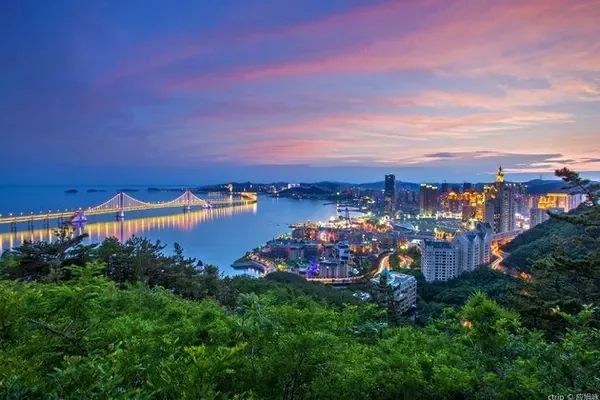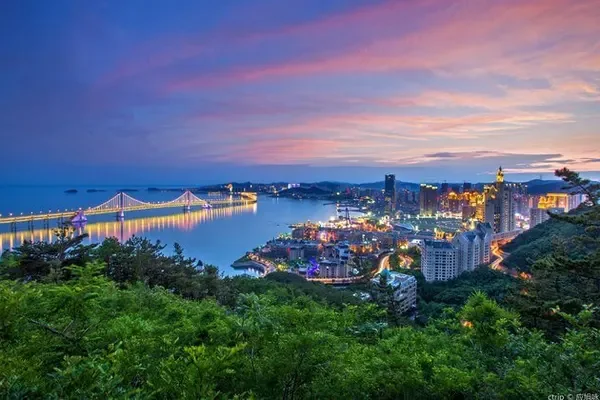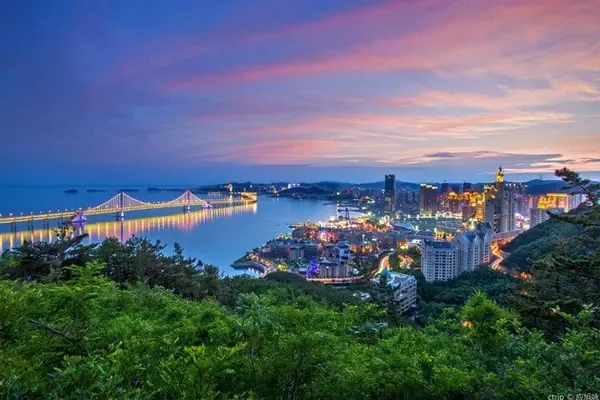At the foot of Baihua Mountain, Qingshui Town, Mentougou, Beijing, there is a small village named Huang'antuo. In the 1950s, when China's agricultural economy was developing steadily, the planning working group of the Beijing Municipal Bureau of Agriculture and Forestry at that time paid attention to this village. , and formulated a 13-year "Huangantuo Village Agriculture, Forestry and Animal Husbandry Production Cooperative Development Plan". At that time, Chairman Mao Zedong fully affirmed the "13-year plan" of the village after learning about it, and made instructions for it, which made Huang'antuo Village famous.
On October 29, 2015, the reporter and his party went to Mentougou to participate in an activity organized by the party group with the theme of "Keep in mind the history and shoulder the mission bravely". The activity location happened to be Huangantuo Village in Qingshui Town. From the reporter's point of view, this activity is very meaningful. It can not only explore an important page in the history of rural development in my country, but also see the new development of Huangantuo Village today. It can also be regarded as a red trip to the west of Beijing.

Mentougou District is no stranger to Beijingers. It is an old district with a long history and culture and fine revolutionary traditions. As early as 10,000 years ago, the "East Hulin people" of the early Neolithic Age lived here. In the twenty-ninth year of King Yanzhao (283 B.C.), five prefectures, namely Shanggu, Yuyang, Youbeiping, Liaoxi and Liaodong, were established, and the present district belongs to Shanggu and Yuyang. Since then, the subordinate administrative system of the district has undergone repeated changes until it was named Mentougou District in May 1958.

One of the most notable natural features of Mentougou District is that there are many mountains. The total area of the district is 1455 square kilometers, 98.5% of which are mountainous areas. Among the many peaks, there is Lingshan, the highest peak in the city, the beautiful Baihua Mountain, and Miaofeng Mountain, which is rich in roses. The heights of Lingshan Mountain and Baihua Mountain are 2303 meters and 1991 meters respectively, which are higher than the national famous Mount Tai, Huangshan and Lushan.
Huangantuo Village in Qingshui Town is located at the foot of Baihua Mountain. As Qingshui Town in Mentougou, it is located at the turning point of the transition zone from the North China Plain to the Mongolian Plateau. The Baihua Mountain in the west of the capital and the Dongling Mountain in the northwest are side by side with the peaks and mountains and become a natural green barrier in the west of the capital Beijing. . It is named after Qingshui Village, which was established by the government.

Qingshui Town also has a long history. According to historical data: 100,000 years ago, humans had been active in the town. About 30,000 years ago, the climate here was warm and humid, the vegetation was high and lush, birds and animals were dense, and ponds, springs, and ponds abound. Mountain delicacies and wild fruits, fish and mulberry hemp provided a rich source of living materials for our ancestors. Stone halls, caves, and tree nests have prepared shelter for them. 10,000 years ago, the ancient tribes here participated in the Yanhuang War that took place around Lingshan to kill Chiyou. The ancient towns such as Qijiazhuang and Yanjiatai were the jurisdiction of Huangdi City, the capital of the Yellow Emperor at that time. To this day, village names, place names, folk customs, and surnames are all inextricably linked to this war and the Yellow Emperor City.
In short, from ancient times to the present, Qingshui Town has undergone earth-shaking changes in the long history. Now here, not only the township economy, agriculture and forestry, aquaculture, township enterprises, cultural health and other aspects have been developed in an all-round way, but also, relying on the rich tourism resources formed by many scenic spots and historical sites endowed by nature, it is more and more attractive to Beijing. Tourists from all over the country, around Hebei Province and even from all over the country come in droves.
On October 29, 2015, the autumn air was crisp and the sun was shining brightly. The reporter and his party drove from Beijing, heading west along Shunlianshi Road, and arrived at Shimenying Roundabout in Mentougou in less than half an hour's drive. There, Mr. Li Ruicheng, the founder of the Beijing-flavored "City One Pot" brand, a good friend of the day's event guide, led the reporter along the winding mountain road to Huang'antuo Village, Qingshui Town.

After nearly two hours of driving, we finally arrived at Huangantuo Village in Qingshui Town. When the car came to the entrance of the village, the first thing that caught people's eyes was a white marble archway composed of four stone pillars similar to Huabiao. On the left side is "Cathay", in the middle is "Huang'antuo", and on the right is "Min'an". The six big red characters are extremely eye-catching.

The car drove into Huang'antuo, and saw rows of jagged red-roofed houses distributed among them. Lush trees and colorful wild flowers complement each other on both sides of the road. The street lights in the village are all powered by solar energy. The reporter and his party first came to have a rest at Baihua Game Xiangshan Villa. This is a leisure villa integrating sightseeing and picking, catering and accommodation for tourists and vacations in the village.

After a short rest, I heard that Ren Zhengguo, the former secretary of Huang'antuo Village, was very happy to learn about our activities, and was already waiting for us to go to the square with the inscription written by Chairman Mao in the village. Everyone quickly walked down from the villa, met the old secretary and went to the square. On the way, Secretary Ren told us the general situation of Huang'antuo Village.

The geographical location of Huang'antuo is located under the main peak of Baihua Mountain in the southwest of Qingshui Township, 2.3 kilometers away from the main peak. Because the village is located in the middle mountain area and the village is on a flat loess lump, it is named Huang'antuo. The altitude here is 1045 meters, the temperature is low, and the frost-free period is short. However, due to various reasons such as terrain and hydrology, the annual precipitation is relatively high, so there is a saying that "Zhaitang sieves gongs (referring to rain), and dies happily in Huang'antuo". The soil here is carbonate cinnamon, and the vegetation is mainly Quercus liaotungensis, aspen, birch, and eucalyptus. On Baihua Mountain in the southeast of the village, Ruiyun Temple was originally built in the Han Dynasty and rebuilt 38 times in successive dynasties; at the foot of the Nanshan Rock of Laoye Temple, there was originally the "Spiritual Pagoda of the first generation of monks who opened the mountain" built in the Qianlong period of the Qing Dynasty. The village has not been recorded in historical records in the late Qing Dynasty, and Huang'antuo Village began to appear on the map of Wanping County in the Republic of China.

During the Anti-Japanese War, it was the Pingxi Anti-Japanese Base Area, and there were 17 revolutionary martyrs in the village. From 1954 to 1956, Ren Chenglong and Bai Juping were awarded the Beijing Agricultural Model Workers; Chen Zhongguan was awarded the 1954 Beijing Agricultural Model Workers; Wang Tianyuan was awarded the 1962 Beijing Agricultural Model Workers; 1956 From September 15th to 27th, the Communist Party of China successfully held the Eighth National Congress in Beijing. Ren Chenglong, secretary of the party branch and president of the Huangantuo Agriculture, Forestry and Animal Husbandry Production Cooperative, was elected as an official representative to attend the meeting , was cordially received by Chairman Mao and Premier Zhou and other party and state leaders.

While speaking, he came to the foot of the memorial square and walked up slowly along the stone steps. The reporter counted in his heart that there were 100 steps from the bottom to the square. In the center of the back of the square is a red and white statue, the upper part is a sitting bust of Chairman Mao Zedong, and the lower part is a brown-red monument with instructions and inscriptions. On the front of the monument is an inscription written by Chairman Mao himself. On the back is the inscription of Chairman Mao's instructions.

In the square, Ren Zhengguo, Secretary of the Party Branch of Huang'antuo Village, talked about the process of Chairman Mao's inscription. In 1955, the Planning Working Group of the Beijing Municipal Bureau of Agriculture and Forestry, entitled "The Long-term Planning of the Huangantuo Agriculture, Forestry and Animal Husbandry Production Cooperative", was selected to contribute to the book "The Socialist Upsurge in Rural China" edited by Chairman Mao himself.

When entering the book, Chairman Mao wrote a note for this article: "This is a thirteen-year long-term plan, which can be used as a reference for various places. The usefulness of this kind of plan is that it has a long-term goal, so that people's vision can It is a step that is limited in front of the eyes. This kind of plan is only a general direction, and it needs to be concreted with every five-year plan and annual plan for each year. Due to the implementation of several annual plans, the long-term plan will need to be repeated. modified."

The "Huang'antuo" mentioned in the book "The Socialist Upsurge in Rural China" is Huang'antuo Village, Qingshui Town, Mentougou District. At that time, Huang'antuo was the earliest anti-Japanese base area in Pingxi. After the founding of New China, a cooperative was established and a long-term plan was formulated, which was affirmed by Chairman Mao. After Chairman Mao's instructions, the agricultural cooperatives in Qingshui Township set off one climax after another.

Secretary Ren said: Huang'antuo people have never forgotten the honor brought to them by Chairman Mao Zedong's "Notes". So far, the villagers in this village are very simple, and most of the villagers are down-to-earth farming, free from some interference and influence from the outside world.

Back to the completion of the Chairman Mao Memorial Square, the old secretary said: time flies, time flies. For half a century, this important instruction from Chairman Mao has inspired several generations of Huangantuo people to work hard and work hard. Our remote mountain village has also undergone tremendous changes. Looking back on the past, remembering the great man and inspiring future generations, Huangantuo Village built a commemorative square including a statue of Chairman Mao and a monument in 2005, on the occasion of the 50th anniversary of the command.

Although the reporter's visit to Huang'antuo Village was short, we felt that the activity with the theme of "remembering history and shouldering the mission bravely" was worthwhile after knowing the whole story of Chairman Mao's instructions to Huang'antuo Village. Although decades have passed, from one perspective, Chairman Mao's instruction on "making a long-term plan" still has a certain guiding significance and reference function in our various work even today. (Text photo: Feng Ganyong)


